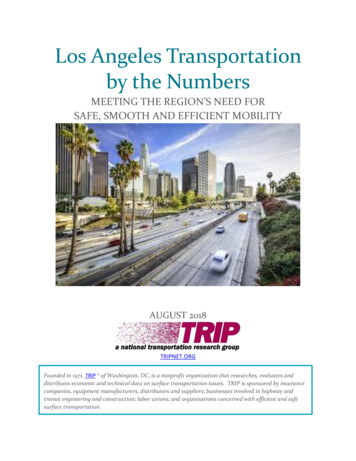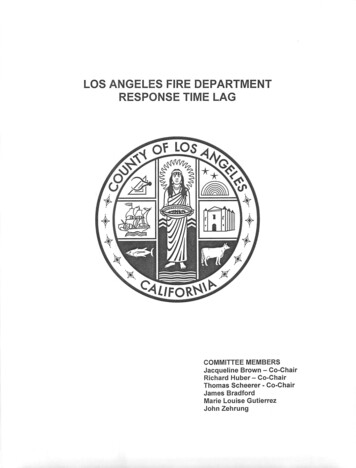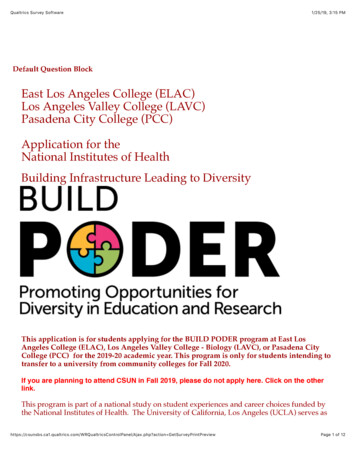
Transcription
Physical Education Frameworkfor California Public SchoolsKindergarten Through Grade TwelveAdopted by theCalifornia State Board of EducationPublished by theCalifornia Department of EducationSacramento, 2009
Physical Education Frameworkfor California Public SchoolsKindergarten Through Grade TwelveDeveloped by theCurriculum Development andSupplemental Materials CommissionAdopted by theCalifornia State Board of EducationPublished by theCalifornia Department of Education
Publishing InformationWhen the Physical Education Framework for California Public Schools was adoptedby the California State Board of Education on September 11, 2008, the membersof the State Board were Ted Mitchell, President; Ruth Bloom, Vice President; JamesAschwanden; Alan Bersin; Yvonne Chan; Don Fisher; Gregory Jones; David Lopez;Kenneth Noonan; and Johnathan Williams.The California State Board of Education approved edits to the Physical EducationFramework for California Public Schools on May 6, 2009. The members of the StateBoard on that date were Ted Mitchell, President; Ruth Bloom, Vice President;Sophia Angelis; James Aschwanden; Rae Belisle; Yvonne Chan; Gregory Jones;David Lopez; Jorge Lopez; and Johnathan Williams.This publication was edited by Faye Ong, working in cooperation with DeborahFranklin, Education Programs Consultant, Curriculum Frameworks and Instructional Resources Division. It was designed and prepared for printing by the staffof CDE Press, with the cover and interior design created and prepared byCheryl McDonald. Typesetting was done by Jeannette Reyes. It was publishedby the Department of Education, 1430 N Street, Sacramento, CA 95814-5901.It was distributed under the provisions of the Library Distribution Act andGovernment Code Section 11096. 2009 by the California Department of EducationAll rights reservedISBN 978-0-8011-1696-4Ordering InformationCopies of this publication are available for sale from the California Department ofEducation. For prices and ordering information, please visit the DepartmentWeb site at http://www.cde.ca.gov/re/pn or call the CDE Press Sales Office at1-800-995-4099. An illustrated Educational Resources Catalog describing publications, videos, and other instructional media available from the Department can beobtained without charge by writing to the CDE Press Sales Office, CaliforniaDepartment of Education, 1430 N Street, Suite 3207, Sacramento, CA 958145901; faxing to 916-323-0823; or calling the CDE Press Sales Office at thetelephone number listed above.NoticeThe guidance Physical Education Framework for California Public Schools is notbinding on local educational agencies or other entities. Except for the statutes, regulations, and court decisions that are referenced herein, the document is exemplary,and compliance with it is not mandatory. (See Education Code Section 33308.5.)
iiiContentsForeword. vAcknowledgments.viiIntroduction . xChapter 1. Vision and Goals for Standards-Based Physical Education .1Chapter 2. Standards-Based Physical Education: KindergartenThrough Grade Five.13Kindergarten.15Grade One .25Grade Two .36Grade Three .47Grade Four .58Grade Five.72Chapter 3. Standards-Based Physical Education: Grades SixThrough Eight .82Grade Six .85Grade Seven .96Grade Eight .104Chapter 4. Standards-Based Physical Education: Grades NineThrough Twelve.113High School Course 1.117High School Course 2.125High School Course 3.134High School Course 4.148Chapter 5. Assessment.157Types of Assessment .158Principles of Assessment.160Assessment Tools.161Assessing the Skills and Concepts Learned .171State-Required Physical Performance Test .184Assessment and the Use of Technology.185Grading Practices in Standards-Based Physical Education .188Chapter 6. Instruction.190Instructional Models .192Establishing a Safe Environment .193Class Management .195Effective Teaching Behaviors .196Principles of Motor Learning .197A Sample Physical Education Lesson.199Instructional Strategies .201Multidisciplinary Opportunities.204
ivChapter 7. Universal Access.206Establishing an Inclusive Environment.207Students Who Are Marginalized.211Accommodating Cultural and Religious Practices .212English Learners.214At-Risk Learners.216Students with Medical Conditions .217Advanced Learners .217Students with Disabilities (IEPs and Section 504 Plans).218Chapter 8. Supporting High-Quality Physical Education .225Administrative Role and Support .226Teacher Leaders.235College and University Support.236Community and Parent Support .236Chapter 9. Instructional Resources.238Evaluation Process.239Evaluation of Instructional Materials.239Evaluation of Equipment and Supplies.243Evaluation of Technology .244Facilities .252AppendixesA: Selected Laws and Regulations.259B: Content Areas of Standards, by Grade Level .281C: The Movement Framework in Games, Gymnastics, and Dance .284D: Concepts and Principles of Biomechanics .286E: Concepts and Principles of Motor Learning.289F: Contraindicated and Alternative Exercises .292G: Standards-Based Report Card, Example #1.297H: Standards-Based Report Card, Example #2.298I: Adapted Physical Education Pre-referral Checklist.301J: Quality Indicators: Physical Education Standards-Based Instruction.303K: Careers in Physical Education.304L: Online Resources.306M: Guidelines for Facilities .309Glossary.312Works Cited.324Additional References .329
vForewordWith the adoption of the Physical Education Model Content Standardsfor California Schools in January 2005, California raised the bar forphysical education instruction. High-quality, standards-based physicaleducation instruction helps students learn not only the skills and knowledge tobe physically fit and active, it also gives them the confidence and positive attitudenecessary to participate in physical activities.The Superintendent’s Task Force on Childhood Obesity, Type 2 Diabetes,and Cardiovascular Disease recommends increasing the quality and quantity ofinstruction in physical education to provide more physical activity and enhancestudent achievement of California’s Physical Education Model Content Standards;including physical education as core curriculum; and treating physical activity asessential to all students’ education and health.The Physical Education Framework for California Public Schools: KindergartenThrough Grade Twelve, adopted by the State Board of Education on September11, 2008, is an essential resource for the development, implementation, andevaluation of standards-based physical education programs and instructionto meet the recommendations of the task force. Its adoption reinforces theimportance of physical education as a vital component of our students’ educational experience and its contribution to each student’s health and well-being,social development, and readiness to learn.The framework charges administrators and teachers with instituting standardsbased physical education instruction and programs that are effective for everystudent. Focused on the model content standards and supported by currentresearch, the framework emphasizes student learning with the goal of helpingevery student adopt a physically active lifestyle. Developed and reviewedby teachers, administrators, and physical education experts, the frameworkfeatures practical examples and scenarios of student learning to assist teachersin planning instruction. The framework describes the why, when, and how ofassessing student learning and presents detailed examples of different types ofassessment. It provides guidance on creating a physically and emotionally safelearning environment. Based on the premise that every student can be successfulin physical education with good instruction and appropriate resources, theframework also offers suggestions for adaptations to meet the instructional needsof students with disabilities or other challenges to learning.Recognizing that effective standards-based physical education programsrequire administrative leadership and support, the framework addresses topicsof interest to school-site and district-level administrators, including professionaldevelopment, curriculum design, instructional and program evaluation, and theselection and maintenance of high-quality instructional resources.
viMost important at a time when more children than ever before are obese andinactive, the framework is a call to action. It maps out a path to a physicallyactive, healthy lifestyle for all students. Open the framework and we’ll start downthe path together.J O’C State Superintendent of PublicInstructionT R. M President, State Boardof Education
viiAcknowledgmentsThe 2009 edition of the Physical Education Framework for California PublicSchools was adopted by the State Board of Education on September 11,2008. When the framework was adopted, the following persons wereserving on the State Board:Ted Mitchell, PresidentRuth Bloom, Vice PresidentJames AschwandenAlan BersinYvonne ChanDon FisherGregory JonesDavid LopezKenneth NoonanJohnathan WilliamsMembers of the Curriculum Development and Supplemental ResourcesCommission serving in May 2008, when the framework was recommended foradoption by the State Board, were:Katherine Crawford, Chair, Alameda Unified School DistrictConstance (Connie) Tate, Vice Chair, San Joaquin County Officeof EducationHope Bjerke, Tehama County Office of EducationJohn Brooks, Oceanside Unified School DistrictLinda Childress, Riverside County Office of EducationPatricia Dixon, Palomar CollegeEducationducationMartha Hernandez, Ventura County Office of EGlee JohnsonChristine Lanphere, Natomas Unified School DistrictLucy Medina, Palm Springs Unified School DistrictBama Medley, Santa Maria-Bonita Elementary School DistrictAssembly Member Gene Mullin, Assembly Education CommitteeDr. RoseMary Parga-Duran, Merced City Elementary School DistrictSenator Jack ScottBecky Sullivan, Sacramento County Office of EducationRichard Wagoner, Los Angeles Unified School DistrictMonica Ward, Riverside Unified School DistrictKevin Wooldridge, Education for Change Charter Management OrganizationNote: Names and affiliations of individuals were current as of the time this publication was developed.
viiiParticipating directly in the development and approval process for the framework were the following members of the Physical Education Subject MatterCommittee from 2005 through 2008:Katherine Crawford (Member 2005, 2007)Patricia Dixon (Member 2005, 2006, 2007, 2008)Martha Hernandez (Member 2008)Mary-Alicia McRae (Vice Chair 2005)(MemberAssembly Member Gene Mullin (Member 2008)Dr. Charles Munger, Jr. (Vice Chair 2006, 2007)Dr. Armida Ornelas (Member 2005, 2006, 2007)Richard Wagoner (Chair 2005, 2006)Monica Ward (Vice Chair 2008)Member 2006)Kevin Wooldridge (Chair 2007, 2008; MemberThe initial draft of the framework was developed by the Physical EducationCurriculum Framework and Criteria Committee (CFCC) between September2006 and April 2007. The State Board of Education and the CurriculumDevelopment and Supplemental Materials Commission commend the followingmembers of the CFCC and extend great appreciation to them. (The affiliationslisted were current at the time of appointment to the committee.)Milissa Glen-Lambert, CFCC Chair, Los Angeles Unified School DistrictDeonna Armijo, Moorpark Unified School DistrictMary Blackman, San Diego County Office of EducationMelissa Bossenmeyer (Retired), California State University, San MarcosDaniel DeJager, San Juan Unified School DistrictCarrie Flint, Lawndale Elementary School DistrictCandace Hashimoto, Pomona Unified School DistrictDarcy Kelly, Manteca Unified School DistrictKara Martin, Mattole Unified School DistrictStacey Mounce, Woodland Joint Unified School DistrictAmanda Parker, Riverside Unified School DistrictMichael Riggs, Bonita Unified School DistrictTimothy Salvino, Newport-Mesa Unified School DistrictSusan Wilkinson, San Jose State UniversityWilhelmina (Willie) Wilson, San Juan Unified School DistrictSpecial appreciation is extended to Janet A. Seaman, P.E.D., Professor Emerita,California State University, Los Angeles.Gratitude is expressed to the primary writer of the 2009 edition, BonnieMohnsen, Ph.D.
ixFor the 2009 edition of the framework, the following managers at the California Department of Education coordinated the overall process for developmentand publication of the document:Thomas Adams, Director, Curriculum Frameworks and InstructionalResources Division; and Executive Director, Curriculum Developmentand Supplemental Materials CommissionSusan Martimo, Administrator, Curriculum Frameworks UnitThe following staff members from the Curriculum Frameworks and Instructional Resources Division contributed to the development of the 2009 editionof the framework:Deborah Franklin, Lead Consultant, Physical Education FrameworkKenneth McDonald, Education Programs ConsultantTerri Yan, AnalystThe California Department of Education staff members who contributedto the development of the 2009 framework were:Linda Hooper, Education Research and Evaluation Consultant, Standardsand Assessment DivisionWalden Williams, Special Education Consultant, Special EducationDivisionDianne Wilson-Graham, Physical Education Consultant, ProfessionalDevelopment and Curriculum Support DivisionAppreciation is expressed to the California State Library staff for assistance inlocating research materials cited in the 2009 framework.
xIntroductionCalifornia is a land of almost limitless opportunity for physical activity.The ocean, lakes, and rivers offer opportunities for swimming andboating; the warm climate offers year-round access to individual, dual,and team sports; the mountains provide opportunities for hiking, orienteering,and snowboarding; and public recreation programs and private businessesoffer opportunities for self-defense, martial arts, fitness, dance, and other physicalactivities. With this diverse climate and geography, Californians can snow ski inthe morning and surf in the afternoon. Because of the richness of the opportunities for physical activities, California is often viewed as a leader in the number ofadults who live healthy lifestyles. Yet California children are at risk of developinghypokinetic diseases. This trend must be reversed, and one important step in thatdirection is the development of this framework to support implementation ofstandards-based physical education.What’s New?The most important new feature of this Physical Education Framework forCalifornia Public Schools is its focus on the content knowledge and skills in thePhysical Education Model Content Standards for California Public Schools. Theframework supports the alignment of curriculum, instruction, assessment, andinstructional resources to the state-adopted model content standards. Specificexamples for implementing and assessing the standards are provided along withguidance for understanding the standards. Finally, the importance of every student achieving grade-level and course-level standards in preparation for the nextlevel is emphasized.When compared with the 1994 Physical Education Framework, this newframework provides: A stronger focus on student learning and the needs of the learnerCurrent research referencesA standards-based lesson structureA more user-friendly display with charts, graphs, and illustrationsExamples of standards-based report cardsA greater emphasis on time spent in moderate to vigorous physical activityOrganization of the FrameworkThis framework is organized to assist educators with implementing standardsbased physical education instruction.For teachers, the framework supports instruction for student mastery of thephysical education model content standards. Focusing on the tools for standards-based instruction, the framework highlights the instructional content of
xithe model content standards, student assessments, instructional considerations,universal access, support, and instructional resources.The framework defines administrators’ roles and the responsibilities that areunique to physical education. In Chapter 8 the framework delineates the administrative roles and support crucial to a successful physical education program.Some topics of interest to administrators include hiring practices, supervision ofteachers, professional development in physical education, the importance of asafe learning environment, and program development and evaluation in physicaleducation.Chapter 1 presents a new vision for physical education instruction; explainsthe purpose of the framework; identifies goals for administrators, teachers, andstudents; and examines the challenges to implementing the new vision forphysical education instruction.Chapters 2 through 4 highlight the standards-based curriculum content for thegrade-level spans (kindergarten through grade five, six through eight, and ninethrough twelve). The chapters include an overview of the grade level or courselevel, standards at a glance, learning “snapshots,” and a list of the state-adoptedmodel content standards. Each grade-span section begins with a look at students’ developmental capabilities. This section introduces some of the grade- andcourse-level knowledge and skills contained within the standards. “At a Glance”sections contain the five overarching standards for elementary and middle schooland three overarching standards for high school. “Learning Snapshots” each provide a window into the teaching of a grade- or course-level standard, illustrate thestandard in action, and offer instructional suggestions. Throughout the framework, examples and suggestions are provided. They are not requirements; theyare intended as beginning points to help educators develop physical educationlessons, assessments, policies, and procedures.Chapter 5 guides the development of appropriate assessment tools andmethods to ensure that instruction is effective and every student’s progresstoward achieving specific knowledge and skills is measured. Chapter 6 providessuggestions on effective classroom practices and instructional strategies. Chapter7 suggests specific strategies to promote access to appropriate standards-basedcurriculum for every student. Chapter 8 describes the systems of support thatshould be in place for effective implementation of a rigorous and coherentphysical education curriculum. Chapter 9 provides specific guidelines for theselection of instructional resources, including instructional materials, equipmentand supplies, technology, and facilities.
1Vision and Goalsfor Standards-BasedPhysical Education
2Chapter 1Vision and Goalsfor Standards-BasedPhysical EducationFast-forward to the year 2020. A generation of students in California isbenefiting from standards-based physical education instruction. As youngadults these individuals are physically active and fit. They understand thebenefits of regular physical activity and know how to plan and implement theirown fitness-and-wellness programs. Having mastered the necessary movementskills to participate confidently in many different forms of physical activity, theyare ready to challenge themselves by pursuing new forms of movement. Theseyoung adults analyze their own movement performance on the basis of biomechanics principles. They develop their own learning plans for improving theirmotor skills and learning new ones. With an understanding of developmentallyappropriate activities, they can plan and implement physical activities for youngchildren and children with special needs. They also enjoy the social interactionsthat arise out of their involvement in physical activity and take responsibility fortheir interactions with others. They will maintain an active and healthy lifestylethroughout their lives.Looking at physical education classes across the state in 2020, educatorsenvision students running, jumping, and leaping, exhibiting the joy derived frommovement as they participate in challenging standards-based physical activities.Physical education is a time that students look forward to each day. It is a timeto move, interact with classmates, and feel good about themselves. Every studentcomes to class ready to be active and to learn. The teacher provides standardsbased instruction designed to ensure a successful learning experience for allstudents. Every student has equipment so that he or she can practice throughoutthe instructional period. The class size allows the teacher to provide individualfeedback to every student every day.1 The physical education environment is safeand clean. Every student is getting what he or she needs to become a physicallyeducated adult.Focus on the Physical EducationModel Content StandardsIn January 2005, the State Board of Education adopted the physical educationmodel content standards, which serve as the foundation for instruction at all gradeand course levels. These model content standards represent the essential skills andknowledge that all students need to maintain physically active, healthy lifestyles.These standards focus on the content of physical education and incorporate thedetail required to guide the development of consistent, high-quality physicaleducation instructional programs aimed at student learning and achievement.The standards provide a comprehensive vision of what students need to know andbe able to do at each grade and course level. In addition, the standards provide amodel for high-quality course design.With the adoption of the model content standards, physical education instruction now moves to a standards-based approach. Teachers need to shift from usingFeedback is most effective when it is specific and positive or specific and corrective.1
3established instructional design models to a standards-based approach. Standardsbased instructional design is based on practices and decisions that focus onstudent learning and includes each of these essential steps (as noted in Figure 1.1): Select the standard, or portion of the standard, students will learn. Determine the evidence that best demonstrates that students have learnedthe content. Select or create the assessment tool that is best suited to collect the evidenceof student learning. Plan instruction. Create multiple opportunities for students to learn the content. Deliver effective instruction. Assess student learning of the content. Evaluate assessment data and make decisions about next steps (to reteach thematerial or move on to new material).Figure 1.1 Standards-Based Instructional Design Process Select a standard Move onOR Determineevidence oflearning SelectassessmenttoolReteach Planinstruction Evaluateassessmentdata Createlearningopportunities Assess studentlearning DelivereffectiveinstructionChapter 1Vision and Goalsfor Standards-BasedPhysical Education
4Chapter 1Vision and Goalsfor Standards-BasedPhysical EducationThe Physical Education Model Content Standards for California Public Schoolsaffirms the standing of physical education as an academic content area. Thestandards highlight the fact that participation in physical activity is not the sameas learning the content in physical education. Every grade- and course-levelstandard should be taught and assessed for student learning. With adequateinstruction and sustained effort, every student should be able to achieve thestandards; however, some students with special needs may require appropriateaccommodations, adaptations, or modifications to meet the standards. Decisionsabout how students achieve mastery of the model content standards are best leftto teachers, schools, and local educational agencies.Overarching Standards for KindergartenThrough Grade EightThe five overarching model content standards for elementary and middleschool students are as follows:Overarching Standard 1: Students demonstrate the motor skills andmovement patterns needed to perform a variety of physical activities.Overarching Standard 2: Students demonstrate knowledge of movementconcepts, principles, and strategies that apply to the learning and performanceof physical activities.Overarching Standard 3: Students assess and maintain a level of physicalfitness to improve health and performance.Overarching Standard 4: Students demonstrate knowledge of physical fitnessconcepts, principles, and strategies to improve health and performance.Overarching Standard 5: Students demonstrate and utilize knowledge ofpsychological and sociological concepts, principles, and strategies that applyto the learning and performance of physical activity.Overarching Standards for High SchoolWhen students reach ninth grade, they are ready to integrate all that theyknow with all that they can do. For high school youths, the five overarching standards for kindergarten through grade eight are consolidated into three overarching standards. Essentially, Overarching Standard 1 incorporates Standards 1 and2 from kindergarten through eighth grade; Overarching Standard 2 incorporatesStandards 3 and 4; and Overarching Standard 3 incorporates Standa
!e Physical Education Framework for California Public Schools: Kindergarten !rough Grade Twelve, adopted by the State Board of Education on September 11, 2008, is an essential resource for the development, implementation, and evaluation of standards-based physical education programs and instruction to meet the recommendations of the task force.
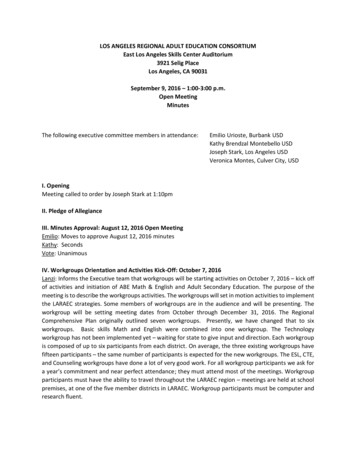
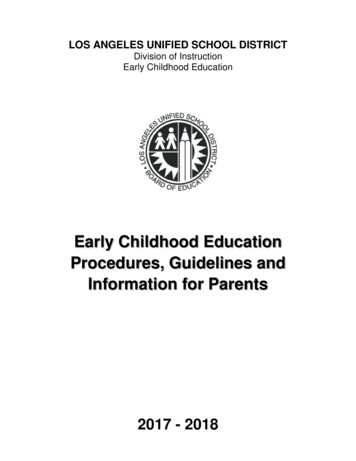
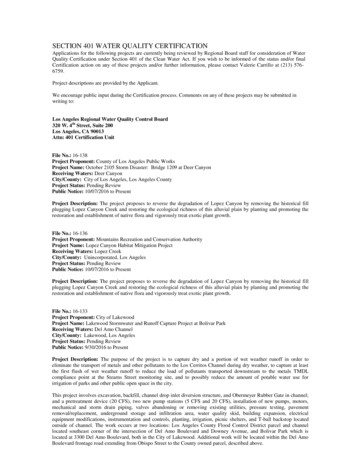
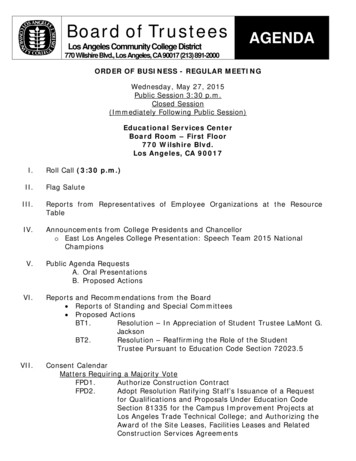

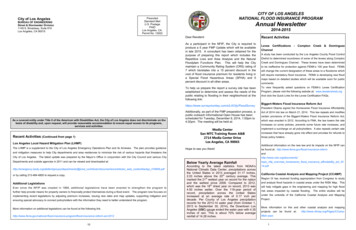
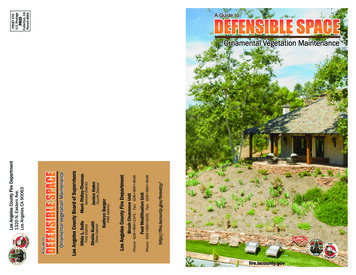
![bTBiesaFn Ep k BIsðèl EdleyIgsmnwgTTYl - calfund [.] org](/img/39/preschool-toolkit-cambodian.jpg)
